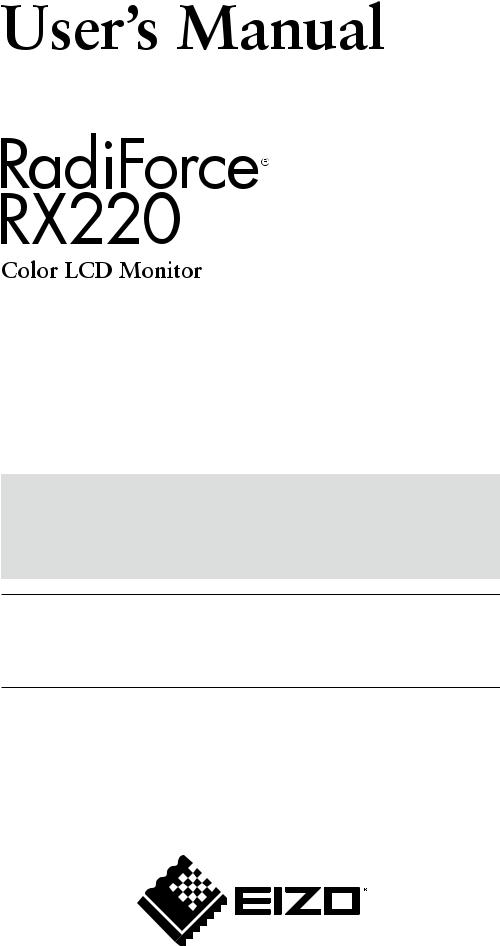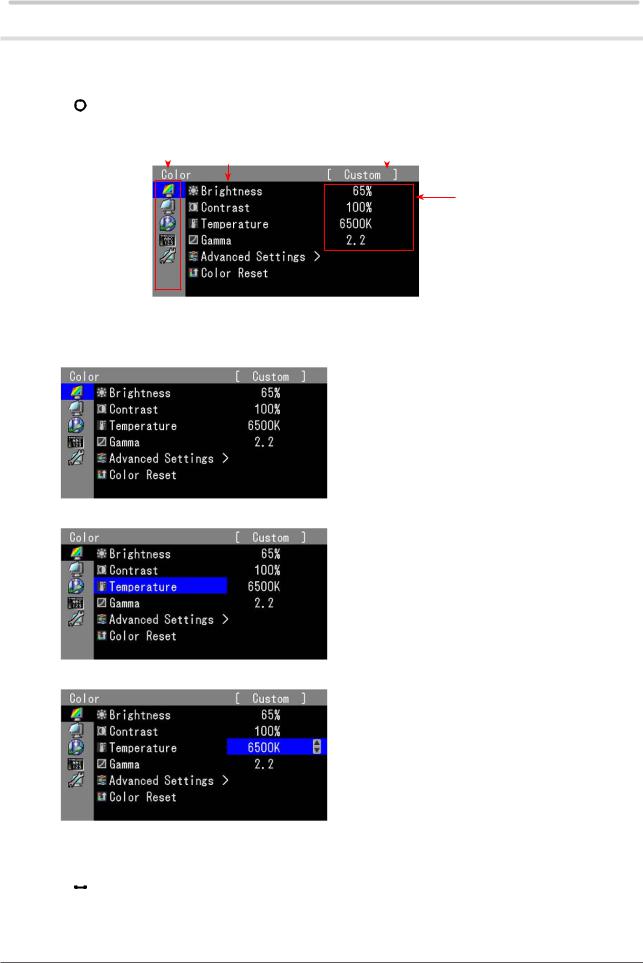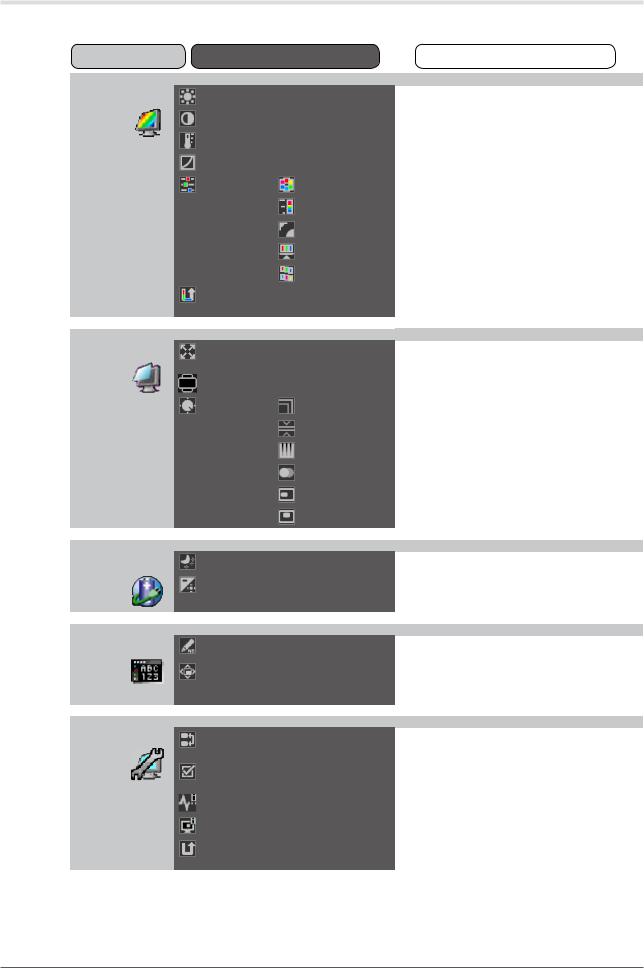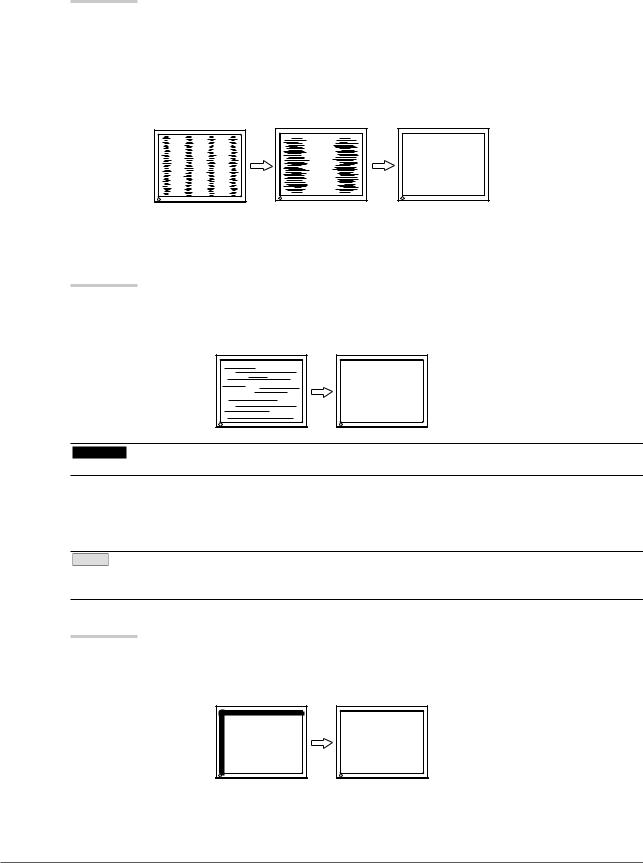Eizo RX220 User Manual

Important
Please read PRECAUTIONS, this User’s Manual and Setup Manual (separate volume) carefully to familiarize yourself with safe and effective usage.
•Please read the Setup Manual (separate volume)
•The latest User’s Manual is available for download from our site: http://www.radiforce.com

Product specification may vary with sales areas.
Confirm the specification in the manual written in language of the region of purchase.
•It shall be assured that the final system is in compliance to IEC60601-1-1 requirement.
•Power supplied equipment can emit electromagnetic waves, that could influence, limit or result in malfunction of the monitor.
Install the equipment in a controlled environment, where such effects are avoided.
•This is a monitor intended for use in a medical image system. It does not support the display of mammography images for diagnosis.
Copyright© 2009 EIZO NANAO CORPORATION All rights reserved.
No part of this manual may be reproduced, stored in a retrieval system, or transmitted, in any form or by any means, electronic, mechanical, or otherwise, without the prior written permission of EIZO NANAO
CORPORATION.
EIZO NANAO CORPORATION is under no obligation to hold any submitted material or information confidential unless prior arrangements are made pursuant to EIZO NANAO CORPORATION’s receipt of said information.
Although every effort has been made to ensure that this manual provides up-to-date information, please note that EIZO monitor specifications are subject to change without notice.
Apple, Macintosh and Mac OS are registered trademarks of Apple Inc.
VGA is a registered trademark of International Business Machines Corporation.
Windows and Windows Vista are registered trademarks of Microsoft Corporation in the United States and other countries. The round gothic bold bit map font used for this product is designed by Ricoh.
DisplayPort icon and VESA are trademarks and registered trademarks of Video Electronics Standards Association.
PowerManager is a trademark of EIZO NANAO CORPORATION.
EIZO, EIZO Logo, RadiCS, RadiForce, RadiNET and ScreenManager are registered trademarks of EIZO NANAO
CORPORATION in Japan and other countries.
All other trademarks are the properties of their respective owners.

Notice for this monitor
This product is suited to display medical images of such modalities as MRI and CT. It does not support the display of mammography images for diagnosis.
This product has been adjusted specifically for use in the region to which it was originally shipped. If the product is used outside the region, it may not operate as specified in the specifications.
This product may not be covered by warranty for uses other than those described in this manual.
The specifications noted in this manual are only applicable for power cords and signal cables specified by us.
Use optional products manufactured or specified by us with this product.
As it takes about 30 minutes for the performance of electrical parts to stabilize, adjust the monitor 30 minutes or more after the monitor power has been turned on.
In order to suppress the luminosity change by long-term use and to maintain the stable luminosity, use of a monitor in lower brightness is recommended.
When the screen image is changed after displaying the same image for extended periods of time, an afterimage may appear. Use the screen saver or power save function to avoid displaying the same image for extended periods of time.
Periodic cleaning is recommended to keep the monitor looking new and to prolong its operation lifetime. (Refer to
“Cleaning” on the next page.)
The screen may have defective pixels. These pixels may appear as slightly light or dark area on the screen. This is due to the characteristics of the panel itself, and not the product.
The backlight of the LCD panel has a fixed life span. When the screen becomes dark or begins to flicker, please contact your dealer.
Do not press on the panel or edge of the frame strongly, as this may result in the display malfunction, such as the interference patterns, etc. If pressure is continually applied to the LCD panel, it may deteriorate or damage your LCD panel. (If the pressure marks remain on the LCD panel, leave the monitor with a white or black screen. The symptom may disappear.)
Do not scratch or press on the panel with any sharp objects, such as a pencil or pen as this may result in damage to the panel. Do not attempt to brush with tissues as this may scratch the LCD panel.
When the monitor is cold and brought into a room or the room temperature goes up quickly, dew condensation may occur inside and outside the monitor. In that case, do not turn the monitor on and wait until dew condensation disappears, otherwise it may cause some damages to the monitor.

Cleaning
Attention
•Never use any solvents or chemicals, such as thinner, benzene, wax, alcohol, disinfectant, and abrasive cleaner, which may damage the cabinet or LCD panel.
NOTE
•Optional ScreenCleaner is recommended for cleaning the panel surface.
●LCD Panel
•Clean the LCD panel with a soft cloth such as cotton cloth or lens cleaning paper.
•Remove persistent stains gently with a cloth dampened with a little water, and then clean the LCD panel again with a dry cloth for better finishing.
●Cabinet
•Clean the cabinet with a soft cloth dampened with a little mild detergent.
To use the monitor comfortably
•An excessively dark or bright screen may affect your eyes. Adjust the brightness of the monitor according to the environmental conditions.
•Staring at the monitor for a long time tires your eyes. Take a 10-minute rest every hour.

CONTENTS
Cover |
|
............................................................. |
1 |
|
|
||
..............................................Notice for this monitor |
3 |
||
CONTENTS............................................................. |
5 |
||
Chapter 1 |
........................................Introduction |
6 |
|
1-1. |
............................................................Features |
6 |
|
1-2. |
Switches and Indicators................................. |
7 |
|
1-3. |
Utility Disk........................................................ |
7 |
|
●Disk contents and software overview................. |
7 |
||
●To RadiCS LE or |
|
||
|
ScreenManager Pro for Medical......................... |
7 |
|
1- 4. Basic Operation and Functions..................... |
8 |
||
Basic operation of Adjustment menu................. |
8 |
||
Functions................................................................ |
9 |
||
Chapter 2 |
Adjusting Screen............................. |
10 |
|
...............................2-1. Setting Screen Resolution |
10 |
||
Compatible Resolutions/Frequencies............... |
10 |
||
Setting Resolution................................................ |
10 |
||
●Windows Vista................................................... |
10 |
||
●Windows XP...................................................... |
10 |
||
●Mac OS X.......................................................... |
10 |
||
2-2. |
Displaying Screen Correctly......................... |
11 |
|
Digital Input........................................................... |
11 |
||
Analog Input.......................................................... |
11 |
||
2-3. |
Color Adjustment............................................ |
15 |
|
●To select the display mode (CAL Switch).......... |
15 |
||
●To perform advanced adjustments.................... |
15 |
||
●Adjustment items in each mode........................ |
16 |
||
●To adjust the brightness [Brightness]................ |
17 |
||
●To adjust the contrast [Contrast]........................ |
17 |
||
●To adjust the color temperature |
|
||
|
[Temperature].................................................... |
17 |
|
●To adjust the gamma value [Gamma]................ |
18 |
||
●To adjust the hue [Hue]...................................... |
18 |
||
●To adjust the color saturation [Saturation]......... |
18 |
||
●To enhance the outline of the image |
|
||
|
[Outline Enhancer]............................................. |
19 |
|
●To adjust the gain value [Gain].......................... |
19 |
||
●To adjust six colors [6 Colors]............................ |
19 |
||
2-4. |
Displaying Lower Resolutions..................... |
20 |
|
●To change screen size [Screen Size]............... |
20 |
||
Chapter 3 |
Setting Monitor................................. |
21 |
|
3-1. |
Enabling/Disabling Mode Selection |
|
|
|
[Mode Preset].................................................. |
21 |
|
3-2. |
Locking Switches [Key Lock]........................ |
21 |
|
3-3. |
Setting the EIZO Logo Display [Logo]......... |
22 |
|
3-4. |
Setting Orientation ....................................... |
22 |
|
●Using Image Rotation Function |
|
||
|
[Image Rotation]............................................... |
22 |
|
3-5. |
Setting Language [Language]...................... |
23 |
|
3-6. |
Setting the Display Position of the |
|
|
|
Adjustment Menu [Menu Position].............. |
23 |
|
3-7. |
Restoring the Default Setting....................... |
24 |
|
●To reset color adjustment values |
|
||
|
[Color Reset]...................................................... |
24 |
|
●To reset all adjustments to the factory default |
|
||
|
settings [All Reset]............................................. |
24 |
|
Chapter 4 Power Saving Function................... |
25 |
||
4-1. |
......Setting the Power Saving [Power Save] |
25 |
|
4-2. |
Setting Power Indicator [Power Indicator].. 25 |
||
Chapter 5 |
Troubleshooting............................... |
26 |
|
Chapter 6 |
..........................................Reference |
29 |
|
6-1. |
...........................................Attaching an Arm |
29 |
|
6-2. |
Connecting More than Two PCs to the |
|
|
|
Monitor............................................................ |
30 |
|
●To switch the input signal.................................. |
30 |
||
●To set input signal selection [Input Selection]... |
31 |
||
6-3. |
Making Use of USB (Universal Serial Bus). 32 |
||
●Required System Environment......................... |
32 |
||
●Connection Procedure |
|
||
|
(Setup of USB Function)................................... |
32 |
|
6-4. |
Displaying Monitor Information................... |
33 |
|
●Displaying signal information [Signal Info]........ |
33 |
||
●Displaying monitor information [Monitor Info]... |
33 |
||
6-5. |
Specifications................................................ |
34 |
|
6-6. |
Glossary.......................................................... |
38 |
|
6-7. |
Preset Timing................................................. |
40 |
|
FCC Declaration of Conformity.......................... |
41 |
||
..................................................EMC Information |
42 |
||
CONTENTS

Chapter 1 Introduction
Thank you very much for choosing an EIZO Color Monitor.
1-1. Features
•Resolution: 2M pixels (Portrait : 1200 × 1600 dots (H × V))
•Applicable to DisplayPort (applicable to 8 bit or 10 bit, not applicable to audio signals)
•3 signal input terminals (DVI-I x 2, DisplayPort x 1)
•CAL Switch function for selecting an optimal calibration mode
“2-3. To select the display mode (CAL Switch)” (page 15)
•DICOM mode (CAL Switch function) (page 38)
•The quality control software “RadiCS LE” (for Windows) used to calibrate the monitor is included
“1-3. Utility Disk” (page 7)
•The software “ScreenManager Pro for Medical” (for Windows) to adjust the screen using the mouse
and keyboard is included
“1-3. Utility Disk” (page 7)
•Frame Synchronous mode supported (59 - 61 Hz)
•HDCP (High-bandwidth Digital Content Interface)
Chapter 1 Introduction

1-2. Switches and Indicators
Adjustment menu
Switch
1 2 3 

 7
7
1. |
switch |
5. |
switch |
2. |
switch |
6. |
switch |
3. |
switch |
7. |
Power Indicator |
4. |
switch |
|
|
|
|
Indicator status |
Operation status |
|
Green |
|
The screen is displayed |
Orange |
|
Power saving |
Off |
|
Main Power Switch / Power Switch off |
1-3. Utility Disk
An “EIZO LCD Utility Disk” (CD-ROM) is supplied with the monitor. The following table shows the disk contents and the overview of the software programs.
● Disk contents and software overview
The disk includes application software programs for adjustment, and User’s Manual. Refer to “Readme. txt” file on the disk for software startup procedures or file access procedures.
Item |
Overview |
A “Readme.txt” file |
|
|
|
RadiCS LE (for Windows) |
RadiCS LE is quality control software used to calibrate the |
|
monitor and manage the calibration history. (A PC must be |
|
connected to the monitor with the supplied USB cable.) Refer |
|
to the description later. |
|
|
ScreenManager Pro for Medical |
A utility software program to control monitor adjustments from |
(for Windows) |
a PC using its mouse and keyboard. (A PC must be connected |
|
to the monitor with the supplied USB cable.) Refer to the |
|
description later. |
|
|
User’s Manual (PDF file) |
|
|
|
● To RadiCS LE or ScreenManager Pro for Medical
Refer to the corresponding User’s Manual on the CD-ROM disk in order to install and use the software. When using this software, you will need to connect a PC to the monitor with the supplied USB cable. For more information refer to the “6-3. Making Use of USB (Universal Serial Bus)” (page 32).
Chapter 1 Introduction

1- 4. Basic Operation and Functions
Basic operation of Adjustment menu
1 Displaying Adjustment Menu
Press .
The adjustment menu appears.
Menu title |
Item |
Current mode |
||
|
|
|
|
|
Settings
Menu 
2 Adjusting/Setting
1. Choose a menu to adjust/set with 
 , and press
, and press  .
.
2. Choose an item to adjust/set with  , and press
, and press  .
.
3. Adjust/set the selected item with 
 , and press
, and press  .
.
3 Exiting
Press 
 a few times.
a few times.
The adjustment menu finishes.
Chapter 1 Introduction

Functions
The following table shows all the Adjustment menu’s adjustment and setting menus.
Main Menu |
|
Item |
Adjusting/Setting |
|
|
|
|
|
|
|
|
Color |
Brightness |
|
“2-3. Color Adjustment” (page 15) |
|
|
|
|
|
Contrast |
|
|
|
Temperature |
|
|
|
Gamma |
|
|
|
Advanced |
Hue |
|
|
Settings |
Saturation |
|
|
|
|
|
|
|
Outline Enhancer |
|
|
|
Gain |
|
|
|
6 Colors |
|
|
Color Reset |
|
“3-7. Restoring the Default Setting” |
|
|
(page 24) |
|
|
|
|
|
|
|
|
|
|
|
|
|
Screen |
Screen Size |
|
“2-4. Displaying Lower Resolutions” |
|
|
(page 20) |
|
|
|
|
|
|
Image Rotaion |
“3-4. Setting Orientation” (page 22) |
|
|
|
||
|
Analog |
Auto Adjustment |
“2-2. Displaying Screen Correctly” |
|
Adjustment |
Range Adjustment |
(page 11) |
|
|
||
|
|
|
|
|
|
Clock |
|
|
|
Phase |
|
|
|
Hor.Position |
|
|
|
Ver.Position |
|
|
|
|
|
|
|
|
|
PowerManager |
Power Save |
|
“4-1. Setting the Power Saving” (page 25) |
|
|
|
|
|
Power Indicator |
“4-2. Setting Power Indicator” (page 25) |
|
|
|
||
|
|
|
|
|
|
|
|
|
|
|
|
Menu Settings |
Language |
|
“3-5. Setting Language” (page 23) |
|
|
|
|
|
|
|
|
|
Menu Position |
“3-6. Setting the Display Position of the |
|
|
Adjustment Menu” (page 23) |
||
|
|
|
|
|
|
|
|
|
|
|
|
|
|
|
|
Tools |
Input Selection |
“6-2. Connecting More than Two PCs to the |
|
|
Monitor” (page 30) |
||
|
|
|
|
|
Mode Preset |
|
“3-1. Enabling/Disabling Mode Selection” |
|
|
(page 21) |
|
|
|
|
|
|
Signal Info |
|
“6-4. Displaying Monitor Information” |
|
|
(page 33) |
|
|
Monitor Info |
|
|
|
|
|
|
|
All Reset |
|
“3-7. Restoring the Default Setting” |
|
|
(page 24) |
|
|
|
|
|
*The adjusting/setting function on the <Color> menu depend on the selected Color mode (page 16). The above table shows the sub menus when the “Custom” mode is selected (See “2-3. Color Adjustment” (page 15)).
Chapter 1 Introduction

Chapter 2 Adjusting Screen
2-1. Setting Screen Resolution
Compatible Resolutions/Frequencies
For details on compatible resolutions, refer to “Compatible Resolutions/Frequencies” in the Setup Manual.
Setting Resolution
When you connect the monitor to the PC and find that the resolution is improper, or when you want to change the resolution, follow the procedure below.
●Windows Vista
1.Right-click the mouse anywhere on the desktop except for icons.
2.From the displayed menu, click “Personalize”.
3.On the “Personalization” window, click “Display Settings”.
4.On the “Display Settings” dialog, select the “Monitor” tab and select desired resolution in the
“Resolution” field.
5.Click the “OK” button.
6.When a confirmation dialog is displayed, click “Yes”.
●Windows XP
1.Right-click the mouse anywhere on the desktop except for icons.
2.From the displayed menu, click “Properties”.
3.When the “Display Properties” dialog is displayed, click the “Settings” tab and select desired resolution for “Screen resolution” under “Display”.
4.Click the “OK” button to close the dialog.
●Mac OS X
1.Select “System Preferences” from the Apple menu.
2.When the “System Preferences” dialog is displayed, click “Displays” for “Hardware”.
3.On the displayed dialog, select the “Display” tab and select desired resolution in the “Resolutions” field.
4.Your selection will be reflected immediately. When you are satisfied with the selected resolution, close the window.
10 Chapter 2 Adjusting Screen

2-2. Displaying Screen Correctly
Digital Input
When digital signals are input, images are displayed correctly based on the preset data of the monitor.
When performing advanced adjustment, see “2-3 Color Adjustment” (page 15) and subsequent pages.
Analog Input
Attention
•Wait 30 minutes or more from monitor power on before starting adjustments. (Allow the monitor to warm up for at least 30 minutes before making adjustments.)
The monitor screen adjustment is used to suppress flickering of the screen or adjust screen position and screen size correctly according to the PC to be used.
The auto adjustment function works when filling/satisfying all of the following conditions
•When a signal is input into the monitor for the first time or when the resolution or Vertical/ Horizontal Frequency not displayed before is set
•When signals with the vertical resolution over 480 are input
If the screen is not displayed correctly even after performing the auto adjustment, perform the screen adjustments according to the procedures on the following pages to use the monitor comfortably.
[Adjustment Procedure]
1
●
Perform the auto adjustment.
To adjust flickering, screen position, and screen size automatically [Auto Adjustment]
Procedure
1.Choose <Screen> from the Adjustment menu, and press  .
.
2.Choose <Analog Adjustment> from the <Screen> menu, and press  .
.
3.Choose <Auto Adjustment>, and press  .
.
The auto adjustment function works (the message “In Progress” appears) to correctly adjust the flickering, screen position, and screen size correctly.
When the auto adjustment is completed, a message appears. Select “OK” to confirm the new settings or “Cancel” to restore the previous settings, and press  .
.
Attention
•This function works correctly when an image is fully displayed over the Windows or Macintosh display area. It does not work properly when an image is displayed only on a part of the screen (command prompt window, for example) or when a black background (wallpaper, etc.) is in use.
•This function does not work correctly with some graphics boards.
If the screen is not displayed correctly even after adjusting in step 1 above, perform the adjustments according to the procedures on the following pages. When the screen is displayed correctly, go to step 5 “To adjust color gradation automatically [Range Adjustment]”.
Chapter 2 Adjusting Screen 11

2 Prepare the display pattern for the analog display adjustment.
Download the “Screen adjustment pattern files” from our site: http://www.radiforce.com
NOTE
• For details and instructions on opening the “Screen adjustment pattern files”, refer to the “Readme.txt” file.
3 Perform the auto adjustment again with the analog screen adjustment pattern displayed.
● To adjust flickering, screen position, and screen size automatically [Auto Adjustment]
Procedure
1.Display Pattern 1 of the screen adjustment pattern files in full screen on the monitor.
2.Choose <Screen> from the Adjustment menu, and press  .
.
3.Choose <Analog Adjustment> from the <Screen> menu, and press  .
.
To proceed with the subsequent adjustments, select an item in <Analog Adjustment> of the <Screen> menu.
4.Choose <Auto Adjustment>, and press  .
.
The auto adjustment function works (the message “In Progress” appears) to adjust the flickering, screen position, and screen size correctly.
When the auto adjustment is completed, a message appears. Select “OK” to confirm the new settings or “Cancel” to restore the previous settings, and press  .
.
If the screen is not displayed correctly even after adjusting in step 3 above, perform the adjustments according to the procedures on the following pages. When the screen is displayed correctly, go to step 5 “To adjust color gradation automatically [Range Adjustment]”.
12 Chapter 2 Adjusting Screen

4 Perform advanced adjustments for the following using the <Screen> menu of the <Analog Adjustment>.
Adjust the clock, phase and position, in this order.
● To eliminate vertical bars [Clock]
Procedure
1.Choose <Clock> from the <Analog Adjustment> menu, and press  .
.
2.Adjust the clock with  or
or  .
.
Press 
 slowly so as not to miss the adjustment point.
slowly so as not to miss the adjustment point.
3.Press  to exit the adjustment.
to exit the adjustment.
When blurring, flickering or bars appear on the screen after adjustment, proceed to [Phase] to remove flickering or blurring.
●Remove flickering or blurring [Phase]
Procedure
1.Choose <Phase> from the <Analog Adjustment> menu, and press  .
.
2.Adjust the phase with  or
or  .
.
3.Press  to exit the adjustment.
to exit the adjustment.
Attention
•Flickering or blurring may not be eliminated depending on your PC or graphics board.
●To correct screen position [Hor.Position] [Ver.Position]
NOTE
•Since the number of pixels and the pixel positions are fixed on the LCD monitor, only one position is provided to display images correctly. The position adjustment is made to shift an image to the correct position.
Procedure
1.Choose <Hor.Position> or <Ver.Position> from the <Analog Adjustment> menu, and press  .
.
2.Adjust the position with  or
or  .
.
3.Press  to exit the adjustment.
to exit the adjustment.
Chapter 2 Adjusting Screen 13

5
●
Adjust the color gradation.
To adjust color gradation automatically [Range Adjustment]
Every color gradation (0 to 255) can be displayed by adjusting the signal output level.
Procedure
1.Display Pattern 2 in full screen on the monitor using the screen adjustment pattern files.
2.Choose <Range Adjustment> from the <Analog Adjustment> menu, and press  .
.
The color gradation is adjusted automatically.
When the auto adjustment is completed, a message appears. Select “OK” to confirm the new settings or “Cancel” to restore the precious settings, and press  .
.
3.Close the Pattern 2.
14 Chapter 2 Adjusting Screen
